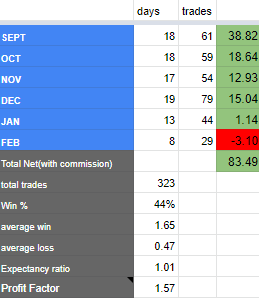Strategy systems always work provided backtesting and forward testing is done properly. Real trades should follow exactly like forward testing or paper testing if not there are two things below not proper
a.) Not accounting for important news events. I don’t trade the nifty during elections , year opening. Some news events like corona can’t be avoided but that’s what stop losses is for.
Or
B.)
- Something wrong with money management
- Ignoring trading psychology
- Being reversal trader
From your post I can say you were trading and some news events came and knocked you off completely. Technical analysis doesn’t work properly during news events.
Secondly I saw you are using ratios. Frankly they don’t work at all. (personal opinion, I don’t know what money management you are using ). Be a trend trader. Risk 2 times ATR or less. Enter 2 lots. Set take profit 1 ATR and bring the stoploss to price you bought after take profit. Let the second one ride till the trend goes. Use an exit indicator like MA, macd or any indicator you find or some trailing STP. Markets trend all the time especially nifty , oil.
Read the book “trading in the zone”. You can’t have targets and timelines because the market it self is inconsistent.
To improve your win rate have an volume indicator. Volume and volatility is what makes market trend. I don’t ever trade if there is no volume. This keeps away losses. The purpose of volume indicator is that reduces your losses. You may have a winrate but avoiding news events , volume indicator ups your odds and with markets trending so all those pips move your account forward only. Only nifty and oil doesn’t require volume because they are heavily traded. If you reached DD 25% take your money off completely. Something is wrong definitely.
Trading psychology :- it’s underrated to talk on this. Literally not many ppl ever talk on this. Frankly whatever system you are trading just sticking to money management and trading psychology can bring results. Psychology is the engine that moves money management.
So during the dry periods(frankly I have not seen which index, stock of commodity , inr pair move in January) don’t take a trade. Discipline absolutely works.
I am the total opposite quite an impulsive guy. But I was little sensible to an extent. I blew 3000 rupees account 3 times trading the INR pairs, lost 10k only very early on. Ate every emotion that came. Thank god I did. It was a total mindf***, mind plays lots of tricks from paper trading to real money. I would suggest this to many if it’s possible. Nothing wrong blowing up very small accounts getting over those insane emotions. So I created a nice system forward tested well and simply followed it. At times I do get the doubt , that dread comes but it’s the forward testing results that we should refer.
Now if you do need to make money switch down to lower time frames. I wouldn’t recommend this as much. 15 mins is as low I would go and trading lower time frames eat so much time.
Desparation adds more fuel too and knocks off completely too especially from psychology perspective.
For maintaining discipline read this book. It’s an amazing mindset book. “Discipline equals freedom” by jocko willink. That changed me so much in so many different ways.
Secondly I would recommend not having goals but if do want to gauge yourself purely from performance standpoint. This what I do
Warren buffet averages 30% for 1 year.
Jimmy Simon’s quant fund algo trader averages 70% for 1 year.
I aim for 6% in backtesting minimum . Try to cross 10% bare minimum.
So assuming 1 year equals = 252 trading days(daily time frame) = 252 candles = 10%
You can do the math for lower TF’s and see how well you fare. Imo if you made 9% consistently you are a great trader.


